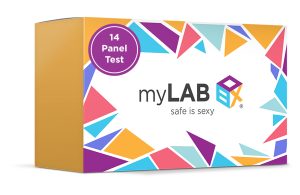Myths & Facts About Gonorrhea

It’s nearly Valentine’s Day, so let’s discuss some myths about gonorrhea! What? That’s not what you were expecting us to say?
Well, believe it or not, gonorrhea is rampant these days. While you’re out there dating, it’s definitely something you want to be aware of. In fact, the Centers for Disease Control and Prevention estimates that there are approximately 820,000 new infections of gonorrhea each year.
A gonorrhea infection, often nicknamed “the clap,” could have serious consequences if it remains undetected and untreated. Because of this, we at myLAB Box want to provide you with a resource so you can protect yourself against this pesky Sexually Transmitted Infection (STI).
Myths About Gonorrhea #1: It’s Easy to Spot a Case of The Clap
Think again! As with many sexually transmitted infections, gonorrhea may not show any easily identifiable symptoms at all. Thanks to the elusive nature of this infection, testing for gonorrhea is a key component of every adult’s overall sexual health.
When gonorrhea symptoms are visible, they typically include itching, swelling, redness, abnormal discharge, tenderness, an urge to urinate, and a general discomfort in the affected area. It can also affect men and women in different ways.
Typical Symptoms in Men:
When present in the genital region, a gonorrhea infection in men may include a white, yellow, or green urethral discharge. This discharge may begin within 14 days after initial exposure to the infection. In some cases, men may also experience testicular and scrotal pain.
Typical Symptoms in Women:
For women, potential gonorrhea symptoms are slightly different. In fact, they are often mild enough to be mistaken for a vaginal yeast infection such as Bacterial Vaginosis (BV) or thrush.
Beyond a discolored discharge, there are other gonorrhea symptoms that exclusively affect women. These may include increased vaginal bleeding or discharge between periods. The infection can also spread to the woman’s uterus or fallopian tubes, causing Pelvic Inflammatory Disease (PID). PID can then lead to further health complications, including internal abscesses and chronic pain. The disease can also damage the fallopian tubes enough to cause infertility.
Pregnant women have an additional worry. When infected with the clap, a pregnant woman may pass gonorrhea to her baby during delivery. In turn, this can lead to blindness, joint infection, or a life-threatening blood infection for the infant.
Myths About Gonorrhea #2: Condoms Are the Only Protection We Need!
Again, this isn’t exactly true. Of course, condoms are very important for all of our sexual health. They do not, however, provide one hundred percent protection against gonorrhea and other STDs. Granted, using condoms will absolutely decrease your risk of being infected, but they are not foolproof. Always keep in mind: condoms can break or slip off. Even worse, they do not always cover the entire skin area that may become infected.
Condoms are a powerful tool in staying safe, but you’ll also want to screen for STDs regularly in order to keep on top of your sexual health.
Myths About Gonorrhea #3: Oral Sex is Safe Sex!
Using condoms during oral sex is a great start. Unfortunately, while condoms can reduce the risk of transmitting mouth infections, they cannot eliminate them completely. For example, many infections can actually be transmitted via skin-to-skin contact. A condom simply cannot fully cover every possible area that is susceptible to infection. Therefore, a gonorrhea infection can easily affect your mouth and throat.
Symptoms of oral gonorrhea may include a sore throat and difficulty swallowing. Performing oral sex on someone that is carrying the clap can transmit an infection to your throat. Similarly, if any of your partners have oral gonorrhea and perform oral sex on you, they can transfer the infection directly to your genitals. It’s very easy to pass the infection back and forth!
Myths About Gonorrhea #4: At Least Anal Sex is Safe!
This is another commonly held myth. Gonorrhea can also affect the rectal region. Much like an oral infection, rectal infections can be easily missed by conventional “genital only” tests given by many clinics and medical facilities. In fact, as many at 20% of extragenital (mouth and rectal) infections will not be detected with conventional testing. myLAB Box’s three-site testing option catches many infections that would otherwise go untreated or unnoticed. Depending on your lifestyle, extragenital testing offers a powerful new option in the fight against “the clap.”
Myths About Gonorrhea #5: STD Testing is a Huge Hassle
Now this is a great myth to bust! Sure, STD testing used to be a massive hassle. Fortunately, thanks to home testing kits, screening for sexually transmitted diseases and infections is easier than ever before! With myLAB Box, now you have a choice.
Feel free to skip the inconvenient trip to the doctor. Routine, scheduled screenings with myLAB Box’s at-home STD testing packages are a convenient way to get a handle on your sexual health. Our results feature the same accuracy as screening in a clinic! You no longer have to take time off work, worry about being seen or deal with awkward conversations. Results from myLAB Box tests are completely private, lab-certified and valid in any doctor’s office.
For more information about gonorrhea symptoms and other sexually transmitted infections that myLAB Box screens for, check out our full STD Symptoms Guide.
Reviewed by Luis Ferdinand M. Papa, MD, MHA
Popular Tests

Total Box
14 Panel STD Test
In Stock – Free Shipping
$369 – $399
